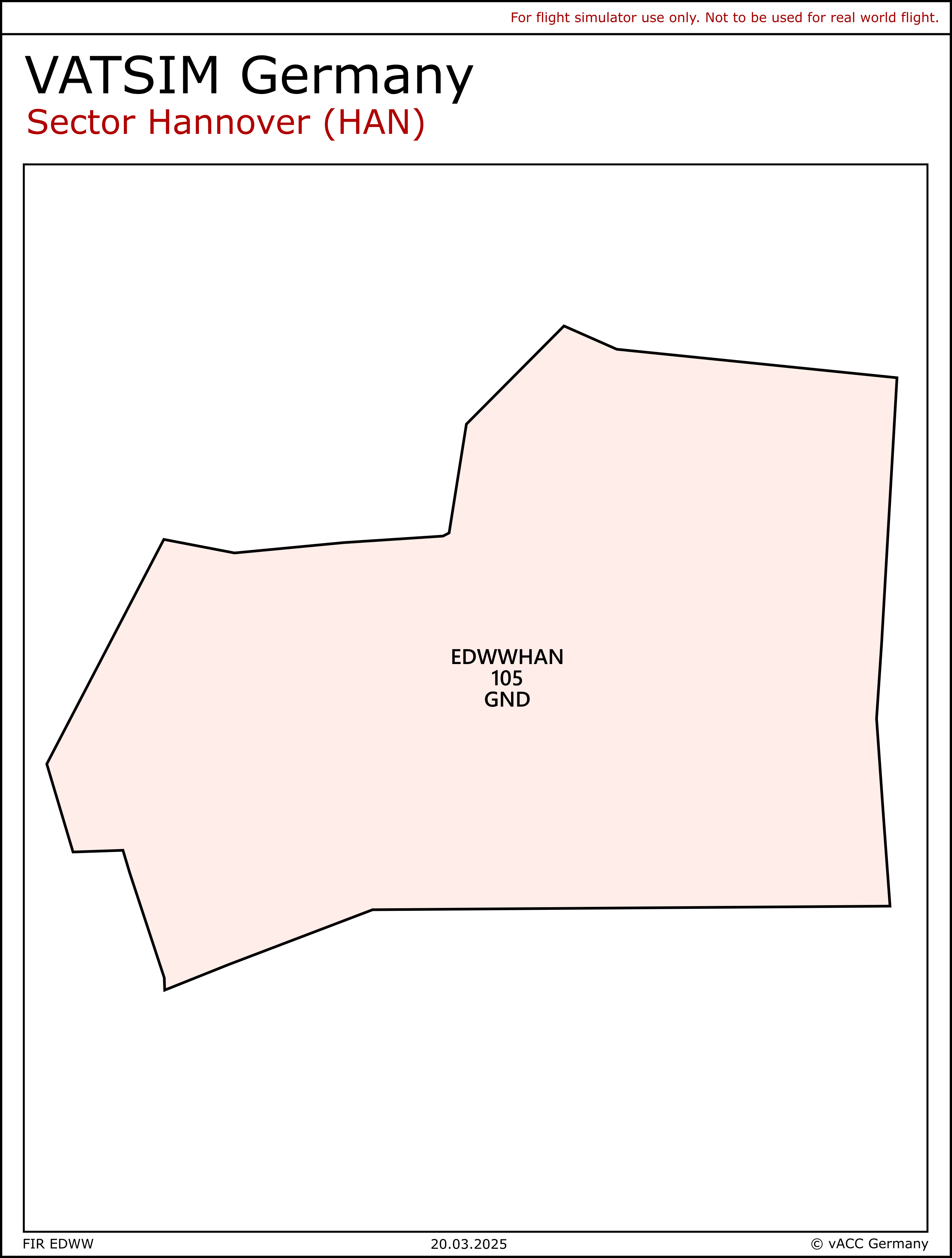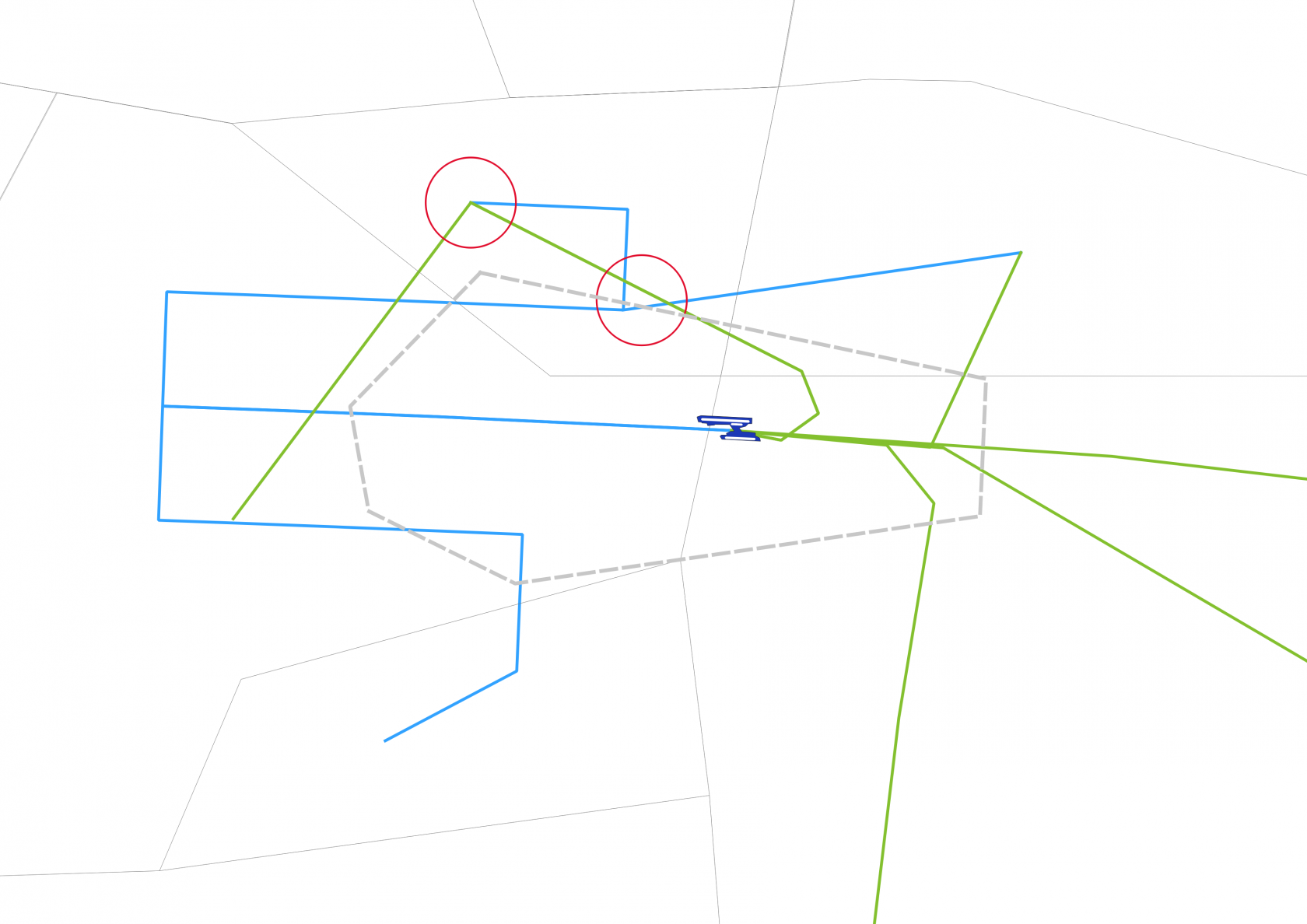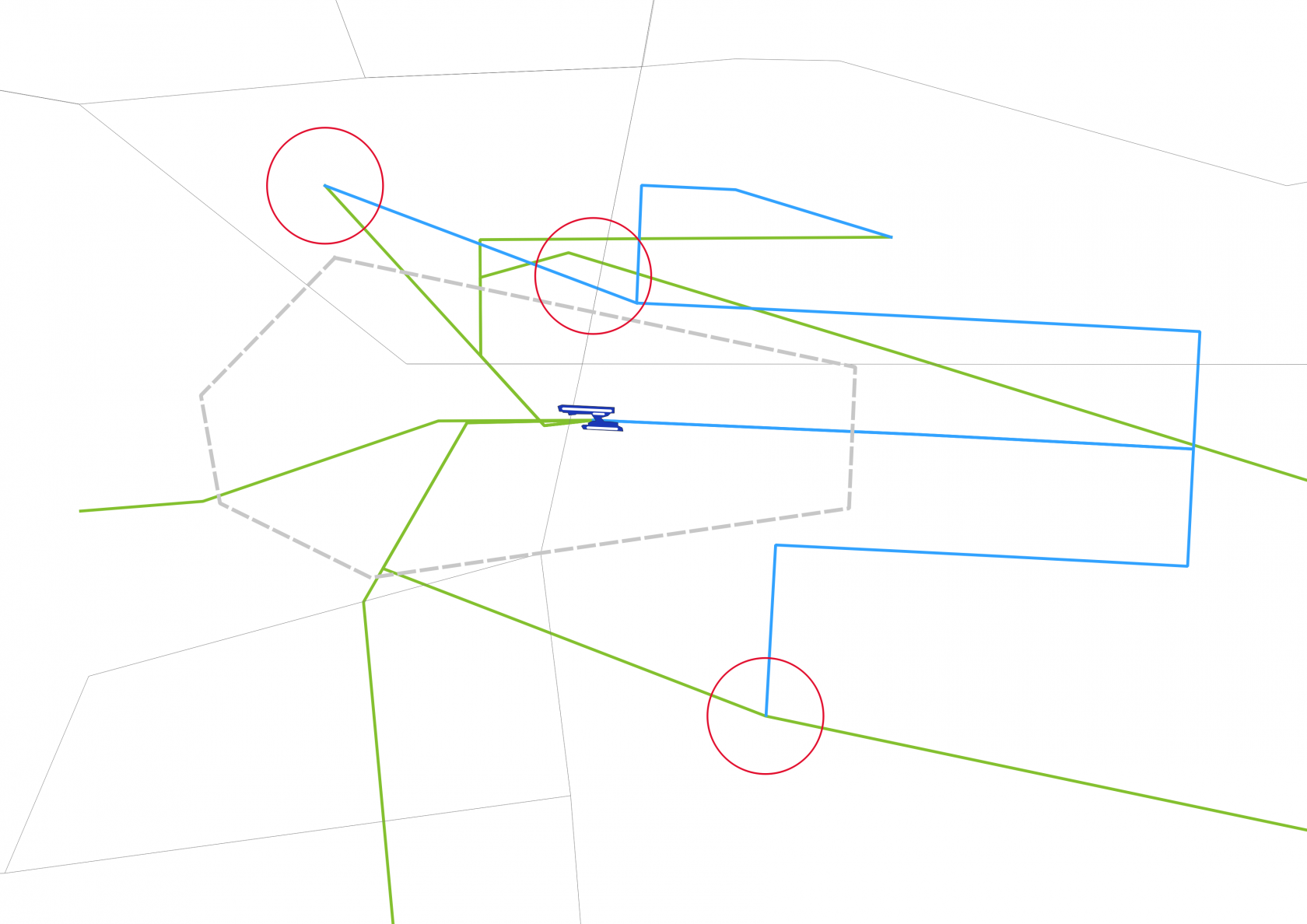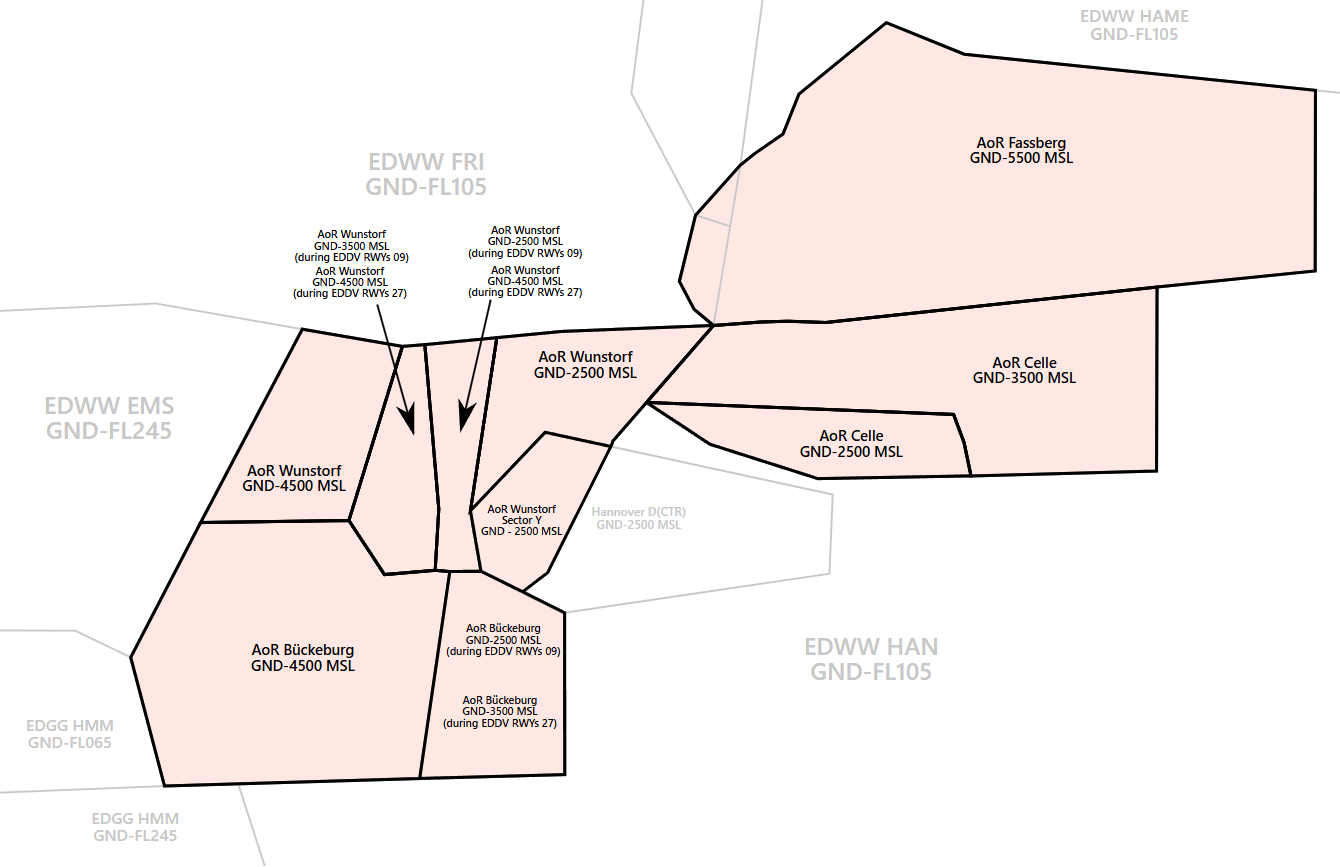Arrival
Area of Responsibility: The Hannover Approach airspace reaches up to FL105 and covers several airports. Civil aerodromes in the area of responsibility are Hannover (EDDV) and Braunschweig-Wolfsburg (EDVE). There are also the military airports Wunstorf (ETNW), Celle (ETHC), Bückeburg (ETHB) and Fassberg (ETHS).
Airspace: The airspace is divided into class D and C airspace. Airspace D reaches from 2500ft to FL65 in the inner ring, and the outer ring reaches from 4500ft to FL65. Above these two segments cover airspace C up to FL100.
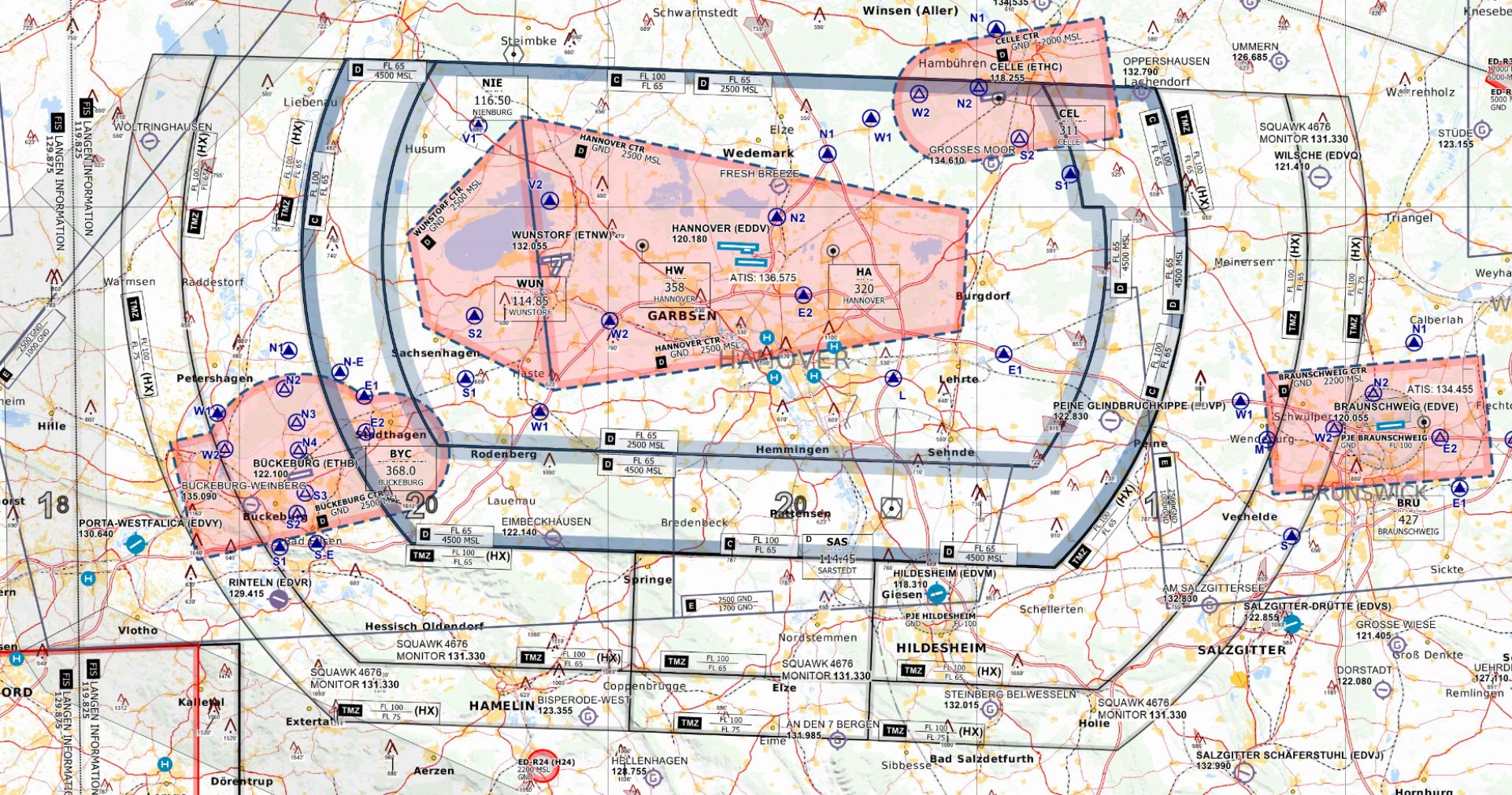 Charlie + Delta + TMZ Airspace of Hannover Airport and Wunstorf - © openflightmaps.org
Charlie + Delta + TMZ Airspace of Hannover Airport and Wunstorf - © openflightmaps.org
There is also a TMZ with HX zones. The main part south of SAS/DLE is always active. The west area is active when runway 09 is in use. The east TMZ area is active when runway 27 is active. The size of the airspace (including) TMZ allows descends in protected airspace.
Minimum Vector Altitude: The minimum vector altitude can be displayed in the DFS Pack with Alt + M.
The south of Hannover has MVA areas which do not allow early descents on low altitudes (e.g. 3500ft). Always comply with restrictions given by the MVA.
Arrivals
Normal Procedures: In normal traffic, headings are used for arriving traffic before reaching the initial approach fix. Early directs to DVxxx in coordination with adjacent Centers are possible as well.
Runway assignment: Bremen Radar always assigns the arrival runway for each aircraft. All heavy aircraft shall land on runway 09L/27R. Light aircraft parking on one of the general aviation aprons is preferred on runway 09L/27R to keep their taxi time short and to relieve the terminal area, for operational reasons runway 09R/27L can be used. All other aircraft can state their preference.
In high-traffic situations, the workload on each runway shall be equal.
Approach Types: Hannover offers different approach types for arriving traffic. All runways are equipped with ILS and authorized for RNP approaches. On runway 09L/27R CAT II/CAT III can be performed.
In direction 27 ILS-Z and ILS-Y are available. They only differ in their intercept altitude, the standard is ILS-Z with an intercept altitude of 3000 ft.
The ILS-Z and ILS-Y can only be used by aircraft with RNAV-1 equipment. Traffic unable for RNAV-1 shall only be cleared via the ILS-X due to the design of the missed approach.
SRA: At EDDV, surveillance radar approaches may be offered on the pilot's request. Check the following tables for the temperature-corrected approach altitudes (Phraseology SRA).
Temperature-corrected surveillance radar approaches (SRA) - EDDV
Runway 09L:
THR 166 ft; Inb. Track 088°
| Temperatur | 10 °C or more | 9 °C to 0 °C | -1 °C to -10 °C | -11 °C to -20 °C | -21 °C to -30 °C |
| OCA (CAT A-D) | 770 | 800 | 820 | 840 | 860 |
| 10 NM | 3300 | 3400 | 3500 | 3600 | 3700 |
| 9 NM | 3000 | 3100 | 3100 | 3200 | 3300 |
| 8 NM | 2700 | 2700 | 2800 | 2900 | 3000 |
| 7 NM | 2400 | 2400 | 2500 | 2600 | 2600 |
| 6 NM | 2000 | 2100 | 2200 | 2200 | 2300 |
| 5 NM | 1700 | 1800 | 1800 | 1900 | 2000 |
| 4 NM | 1400 | 1500 | 1500 | 1600 | 1600 |
| 3 NM | 1100 | 1200 | 1200 | 1200 | 1300 |
| 2,0 NM | 800 | 800 | 820 | 840 | 860 |
| 1,5 NM | 630 | 640 | 660 | 680 | 690 |
| 1,0 NM | 480 | 490 | 500 | 510 | 520 |
| 0,5 NM | 320 | 330 | 330 | 340 | 340 |
Missed approach point: THR, Missed approach procedure: "climb straight ahead 3000 ft"
Runway 09R:
THR 172 ft; Inb. Track 088°
| Temperatur | 10 °C or more | 9 °C to 0 °C | -1 °C to -10 °C | -11 °C to -20 °C | -21 °C to -30 °C |
| OCA (CAT A-D) | 770 | 800 | 820 | 840 | 860 |
| 10 NM | 3300 | 3400 | 3500 | 3600 | 3700 |
| 9 NM | 300 | 3100 | 3200 | 3300 | 3300 |
| 8 NM | 2700 | 2700 | 2800 | 2900 | 3000 |
| 7 NM | 2400 | 2400 | 2500 | 2600 | 2700 |
| 6 NM | 2100 | 2100 | 2200 | 2200 | 2300 |
| 5 NM | 1700 | 1800 | 1900 | 1900 | 2000 |
| 4 NM | 1400 | 1500 | 1500 | 1600 | 1600 |
| 3 NM | 1100 | 1200 | 1200 | 1200 | 1300 |
| 2,0 NM | 790 | 810 | 830 | 850 | 8700 |
| 1,5 NM | 630 | 650 | 670 | 680 | 700 |
| 1,0 NM | 480 | 490 | 500 | 510 | 520 |
| 0,5 NM | 330 | 330 | 340 | 350 | 350 |
Missed approach point: THR, Missed approach procedure: "climb straight ahead 3000 ft"
Runway 27L:
THR 178 ft; Inb. Track 268°
| Temperatur | 10 °C or more | 9 °C to 0 °C | -1 °C to -10 °C | -11 °C to -20 °C | -21 °C to -30 °C |
| OCA (CAT A-D) | 850 | 870 | 890 | 910 | 940 |
| 10 NM | 3300 | 3400 | 3500 | 3600 | 3700 |
| 9 NM | 3000 | 3100 | 3200 | 3300 | 3400 |
| 8 NM | 2700 | 2800 | 2800 | 2900 | 3000 |
| 7 NM | 2400 | 2400 | 2500 | 2600 | 2700 |
| 6 NM | 2100 | 2100 | 2200 | 2200 | 2300 |
| 5 NM | 1800 | 1800 | 1900 | 1900 | 2000 |
| 4 NM | 1400 | 1500 | 1500 | 1600 | 1600 |
| 3 NM | 1100 | 1200 | 1200 | 1200 | 1300 |
| 2,0 NM | 790 | 810 | 830 | 8660 | 880 |
| 1,5 NM | 640 | 660 | 670 | 690 | 700 |
| 1,0 NM | 490 | 500 | 510 | 520 | 530 |
| 0,5 NM | 340 | 340 | 350 | 350 | 360 |
Missed approach point: THR, Missed approach procedure: "climb straight ahead 3000 ft"
Runway 27R:
THR 168 ft; Inb. Track 268°
| Temperatur | 10 °C or more | 9 °C to 0 °C | -1 °C to -10 °C | -11 °C to -20 °C | -21 °C to -30 °C |
| OCA (CAT A-D) | 770 | 800 | 820 | 840 | 860 |
| 10 NM | 3300 | 3400 | 3500 | 3600 | 3700 |
| 9 NM | 3000 | 3100 | 3200 | 3200 | 3300 |
| 8 NM | 2700 | 2700 | 2800 | 2900 | 3000 |
| 7 NM | 2400 | 2400 | 2500 | 2600 | 2600 |
| 6 NM | 2000 | 2100 | 2200 | 2200 | 2300 |
| 5 NM | 1700 | 1800 | 1800 | 1900 | 2000 |
| 4 NM | 1400 | 1500 | 1500 | 1600 | 1600 |
| 3 NM | 1100 | 1200 | 1200 | 1200 | 1300 |
| 2,0 NM | 780 | 800 | 820 | 850 | 870 |
| 1,5 NM | 630 | 650 | 660 | 680 | 690 |
| 1,0 NM | 480 | 490 | 500 | 510 | 520 |
| 0,5 NM | 330 | 330 | 340 | 340 | 350 |
Missed approach point: THR, Missed approach procedure: "climb straight ahead 3000 ft"
Hannover Arrival
Hannover Arrival is responsible for all arriving aircraft in Hannover. There is no area of responsibility for Hannover Arrival. The transfer from Bremen Radar to Hannover Hannover shall be done when the aircraft is cleared:
- north downwind: 4000ft, speed 220 KT
- south downwind: 5000ft, speed 220 KT
These parameters can be adjusted with coordination to achieve a more efficient traffic flow in certain situations.
Standard Spacing and Reduced Separation
Target Spacing: This spacing is the minimum spacing on all runways, which allows the Tower to clear departures in the gaps.
- 4.5 NM diagonal spacing
- on one runway: 6 NM or wake turbulence separation, whichever is greater
Reduced diagonal separation: The airport layout allows a reduced lateral separation minimum on the parallel runway system. Under the following conditions, the lateral separation minimum can be reduced to 1.5 NM. Dependent parallel approaches are allowed when both aircraft use an ILS approach.
- both parallel ILS are operational
- pilots are informed about the use of reduced minima
- radar separation of 3 NM or 1000ft mandatory until both aircraft are established on the localizer course within 15 NM
Reduced radar separation: With the following conditions, it is allowed to reduce the lateral separation on one runway to 2.5 NM.
- preceding aircraft is the same or lower wake turbulence category and not heavy or B757
- runway is dry
- the tower can see all exits visually or with ground radar
Note: all reducing of the separation as stated above shall be coordinated with Tower and is not the standard procedure.
Low visibility operations: During low visibility operations, the amount of movement may decrease. Runway 09R/27L shall be used for departures and 09L/27R for arrivals. To comply with the increased distance of the holding points, the target separation is increased to 5 NM.
Procedures
STARs: By default, STARs will not be cleared by Center. Center will always issue direct clearances to NIE, CEL, SAS or ROBEG. Sector HAN may use the following STARs to guide traffic onto the downwind (previously known as transitions. These STARs will not lead to the final track.
| Waypoint | 27L and 27R | 09R and 09L |
|---|---|---|
| NIE | R | L |
| CEL | R | L |
| ROBEG | R | L |
| SAS | R | L |
Additionally, the following STARs are available to guide the aircraft to NIE, CEL, ROBEG and SAS. These STARs are usually not used as Center will clear directs to these waypoints.
| Waypoint | 27L and 27R | 09R and 09L |
|---|---|---|
| GITEX | X | Z |
| HLZ | X or P | Z or R |
| WERRA | X | Z |
| WRB | X or P | Z or R |
All STARs (except HLZ and WRB P/R) require RNAV-1 equipment. Traffic unable for RNAV-1 shall be guided via radar vectors.
Departures
All departures on published procedures have an initial climb of 4000ft. In Hannover, all SID departures must contact Bremen Radar immediately when airborne without any further handoff.
With the upper limit of FL105, all departures shall be transferred to Center climbing to FL100.
Critical Areas
The procedure design can cause critical situations between arrivals and departures. Areas with a higher risk of approximations between arrivals (blue) and departures (green) are marked red.
|
critical areas 09 operations |
critical areas 27 operations |
Military Airports
Within sector HAN the military aerodromes ETHB, ETHC, ETHS and ETNW are located. Each aerodrome consists of one Tower and one Approach station. Wunstorf Radar will also cover Bückeburg AoR if Bückeburg Radar is offline. Celle Radar will also cover Fassberg AoR if Fassberg Radar is offline.
Every military Tower or Radar station shall inform sector HAN about the opening and closure of each AoR. Within the AoRs, full ATS shall be delegated from Bremen Radar to the military ATC.
Bremen Radar shall maintain half-described radar separation (500ft, 1.5 NM) to all military AoRs. In general, the military AoRs are designed in such a way that they won't conflict with EDDV arrivals and departures in most cases. For runway 09 at EDDV, traffic may need to maintain 4000ft or 5000 ft slightly longer than usual.
Procedures when Military ATC is online and Topdown Service
Every inbound traffic to a military aerodrome shall be coordinated individually between Bremen Radar and the military Radar station before the transfer of communications (transfer level and routing). In most cases, traffic will be transferred on a radar heading.
For IFR departures, the military Tower station will coordinate the IFR clearance with Bremen Radar. The clearance shall include departure routing, initial climb and squawk. Furthermore, the military Tower station will request a departure release from Bremen Radar before issuing a takeoff clearance. Local IFR traffic staying inside the military AoR will not be coordinated with Bremen Radar.
For top-down service, Bremen Radar should only offer published procedures which are known by the controller (e.g. SID and ILS/RNP approach). Bremen Radar shall not provide service for SRA or PAR approaches. VFR top-down service should be performed depending on the controller's workload and procedure knowledge.
Wunstorf
At Wunstorf (ETNW), the published departures route from runway 08 and approach procedures to runway 26 are flown outside of the AoR Wunstorf. Bremen Radar shall coordinate the departure frequency for departures out of RWY 08 individually with Wunstorf Tower and Wunstorf Radar. Approach Procedures and responsibility for runway 26 shall be coordinated individually between Bremen Radar and Wunstorf Radar.
For approaches onto RWY 26 at ETNW, Bremen Radar should issue a departure stop to Hannover Tower until no further conflict potential between departures out of EDDV and the arriving traffic to RWY 26 exists. For departures out of RWY 08 at ETNW, Bremen Radar may create an increased arrival spacing to avoid conflicts between EDDV and ETNW traffic.
When ETNW TWR or APP are offline, Bremen Radar is responsible for top-down service. VFR traffic already in contact with Hannover Tower may be delegated to Hannover Tower entirely after coordination. Bremen Radar will not activate the Wunstorf TWR AoRs unless otherwise coordinated with Hannover Tower. All traffic at ETNW is subject to an individual released from Hannover Tower (see ETNW TWR SOP).

